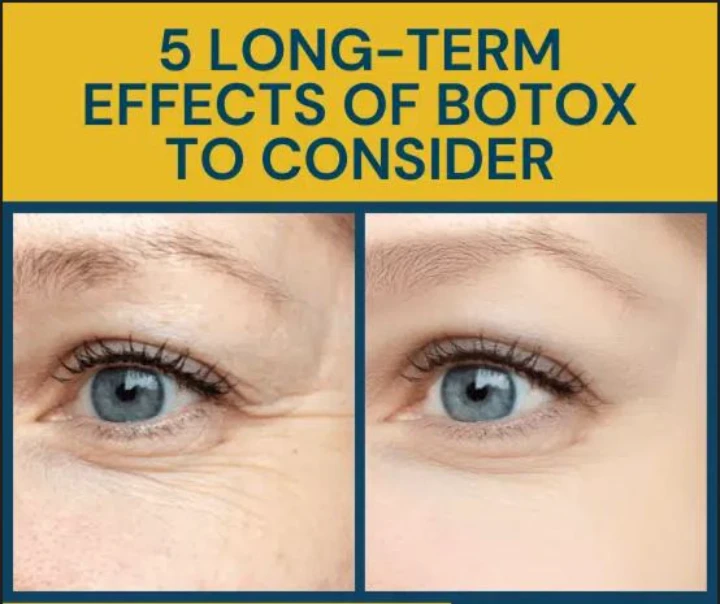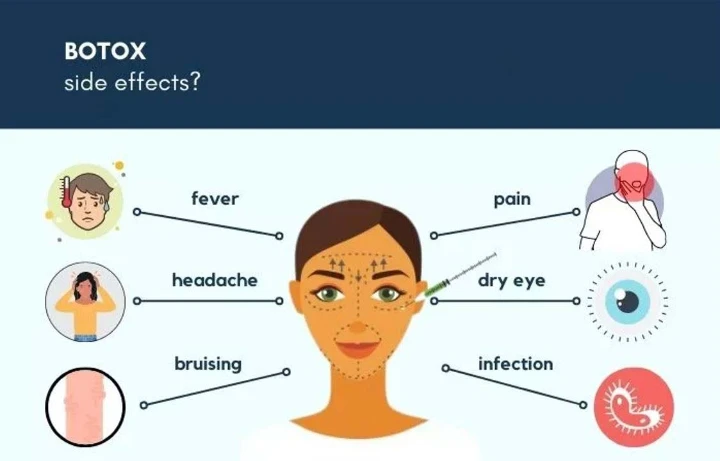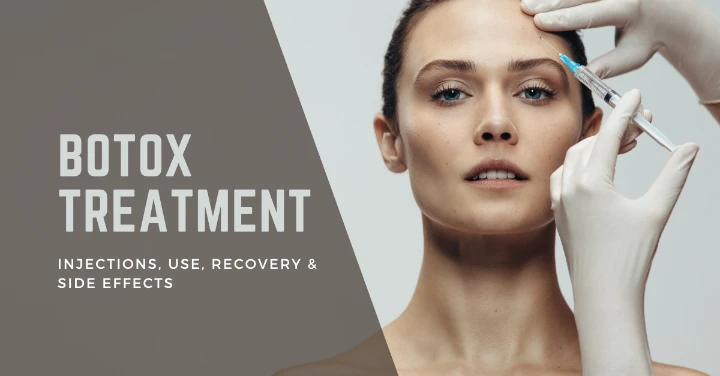Long Term Effects of Botox in 2024
An incredibly popular cosmetic procedure for smoothing wrinkles and restoring a youthful look, Botox has become a key trend for millions of people across the globe. It is a minimally invasive process in which small amounts of botulinum toxin are injected into selected facial muscles to reduce fine lines and wrinkles temporarily. Nevertheless, like all medical interventions, the outcomes must be comprehended and evaluated.
But though most are interested in what Botox is today – a means to smooth out wrinkles or remove them in general, it is better to understand what happens tomorrow. Over time, the muscle reaction to the toxin may diminish, and, consequently, muscle atrophy may occur. This describes a weakening of the muscles from disuse. There are other types of costs: monetary and additional risks. The latter happens when a person becomes immune to botulinum toxin. Thus, the effect of Botox on the skin may weaken or decrease.

In conclusion, this blog post has detailed the long term effects of Botox. As a result, including the potential side effects, dangers, allergies, and composition can help individuals gain a complete picture of what Botox is and is not right for them.
What is Botox Made Of?
But, before we proceed to the long term effects of botox, it is important to comprehend what Botox is. Botox is created from the bacterium Clostridium botulinum, which releases a neurotoxin protein called botulinum toxin. Once this neurotoxin is diluted and administered in little amounts, it can paralyze muscles temporarily. Therefore, injecting Botox temporarily blocks the nerve signals to the muscle forces, thus eliminating their effort to contract.
Such paralysis inevitably smoothes out wrinkles and fine lines because it blocks the muscle movements that lead to their constant repetition. While botulinum toxin is often used for cosmetic purposes to eliminate the appearance of crow’s feet, forehead lines, and frown lines it also has various medical implications, such as the treatment of chronic migraines, excessive sweating, and some muscular conditions.
Botox Side Effects
Immediate Side Effects
Although Botox is generally safe, there are some side effects that are common and may occur immediately following the injection. The common side effects include:

- Bruising and Swelling: it is the most common side effect that occurs immediately after the injection; bruising is variable in-depth and duration. Most bruises heal within a few days as bruising severity depends on the individual’s skin sensitivity and the injection technique used.
- Pain at Injection Site: The area of the injection is painful in some people. This pain subsides quickly and can be controlled with ice or over-the-counter analgesics.
- Headaches: People may experience mild episodic headaches following the treatment. Although rare, they usually last a few days and do not require any treatment. However, if the headaches are significant set Status: preferred, it is likely to do a thorough evaluation.
Potential Side Effects
While rare, some individuals may experience the following side effects after receiving Botox injections:
- Drooping Eyelids: If Botox spreads to muscles close to the eyes, it may cause drooping of the eyelids. This complication is usually temporary and resolves on its own after several weeks.
- Crooked Smile: The doctor says that if the Botox injection affects muscles adjacent to the mouth and cheeks, a crooked smile may be formed: “Don’t worry; it’s also temporary and resolves without intervention.”
- Eye Dryness or Excessive Tearing: Patients who have undergone Botox treatment may also observe excessive eye dryness and tearing. These complications are not associated with a high risk and do not require medical intervention. Dry eyes can be eliminated using special eye drops.
It’s important to consult with your healthcare provider if you experience any of these side effects, as they can provide guidance and support.
Botox Allergy What You Should Know
A severe Botox allergy reaction to Botox is uncommon but conceivable. Symptoms of an allergic reaction to Botox may include itching, rash, or symptoms resembling asthma which include wheezing or having trouble breathing. Swelling around the injection or encircling the face and neck would occur in people.

Rarely, severe reactions to Botox can cause difficulty breathing and swallowing, skin reactions such as blistering or peeling of the skin, or an inability to breathe. If any of those preceding symptoms manifest, it is a sign of a serious and perhaps life-threatening allergic response called anaphylaxis, and there is a dire need for medical attention.
Botox Dangers Assessing the Risks
While Botox is FDA-approved and considered safe for most people, it does come with risks:
- Unintended Paralysis: If Botox diffuses to unintended muscles, it can cause them to get paralyzed leading to unintended effects such as drooping of the eyelids or an uneven smile. Although this side effect is temporary, it can last for months until all the Botox wears off.
- Vision Problems: Sometimes, Botox can reach the muscles around the eyes or the vagina, causing side effects like double vision; blurred or unable to see properly and droopiness. All the aforementioned are temporary and will affect the normal working of an individual until they get better, thereby affecting the quality of work.
- Muscle Weakness: In the treated area or areas, Botox used for many years causes muscle weakness. This can also affect some facial expressions and movements. When repeatedly receiving Botox, for example, the player has relatively loose, thin muscles. These muscles might make the treated location look different.
While these effects are uncommon, any person contemplating Botox should consult their physician about the possible dangers.
Effects of Botox Long Term
Long Term Side Effects of Botox
The long term botox side effects are still being studied, but some known effects include:

- Muscle Atrophy: Use of Botox regularly will cause muscles in the areas where Botox is injected to reduce in size over time due to underuse of the muscles. This underuse is caused by the inability of the muscles to move as they usually would depending on the individual’s state before they began using Botox.
- Resistance to Botox: With time, the use of Botox in some people will spark an antibody-producing mechanism in the body that will resist Botox. The resistance will reduce the effectiveness of Botox, prompting the recipient to raise the amounts injected or look for other similar treatments to tame the adverse aging experience.
- Loss of Natural Facial Expressions: Regular use of Botox will cause an irreversible change in the normal face expressions making one’s face appear unnatural. Facial muscles become inactive due to continued treatment, and this results in a masque appearance that is inexpressive. The user’s ability to express emotions by facial expressions will be limited. All these can lead to self-esteem issues.
Long Term Side Effects of Botox for Migraines
Botox has proven beneficial for chronic migraine sufferers by reducing the frequency of migraine attacks. Administered through a series of injections around the head and neck, Botox helps to relax the muscles and prevent the onset of migraines. However, long term effects of botox use for migraine treatment can also have side effects:
- Neck Pain and Stiffness: These symptoms are the most commonly reported side effects. Patients may experience discomfort and limited range of motion in the neck, which can affect daily activities.
- Swallowing Difficulties: Although rare, some individuals may experience difficulty swallowing, known as dysphagia. This condition can make it challenging to eat and drink, potentially leading to nutritional issues.
It’s important for patients to discuss these potential side effects with their healthcare provider to weigh the benefits and risks of ongoing Botox treatments for migraine management.
Long Term Effects of Botox in Bladder
Botox is also used to treat overactive bladder conditions, providing relief to many patients who struggle with this issue. However, it’s important to be aware of the potential long term effects of botox that may arise from this treatment:
- Urinary Retention: Some patients may find it difficult to empty their bladder completely, which can lead to discomfort and other complications over time.
- Infections: There may be an increased risk of urinary tract infections due to incomplete bladder emptying, which can cause pain, frequent urination, and other bothersome symptoms.
While Botox can be a beneficial treatment for overactive bladder, patients should discuss these potential side effects with their healthcare provider to ensure it’s the right option for them.
Long Term Effects of Botox
Another thing that should be mentioned is the negative aspects of muscle health among long term effects of botox. Despite a lot of people who appeal to this anti-aging method, each person has to realize all the possible long term effects of botox such health care.

Muscle Health
The fact is that people who used Botox for years might have muscle atrophy. The issue is that if the muscle is not used in reaction to injections, it gradually loses its strength and tone due to the constant dose of the toxin. Although it might sound stressful, in the specific context, muscles atrophy but are not weak or harmful.
Skin Quality
There is no evidence suggesting that the use of Botox for a long period could harm the quality of the skin. On the contrary, it is possible for elasticity to improve due to some studies. Additionally, the skin may get very thin as muscles are not active under it, which might cause a somewhat modified texture.
Impact on Aging
Finally, the hottest topic for debate is the long term effects of Botox on the aging process. It should be remembered that Botox itself does not act on aging processes, but only serves as a means of temporarily eliminating its visible manifestations. Thus, after the start of use, a person can continuously monitor his age if such cosmetic procedures are carried out. If these tricks are over and treatment is stopped, the normal aging process will continue.
Safety and Risks of Long Term Botox Use
In conclusion, one should bear in mind the safety profile and possible risks while thinking about long term effects of Botox use.
Safety Profile
As has been stated, Botox is safe when done by qualified experts. The FDA has approved this drug for both medical and cosmetic purposes. Millions of users’ politically complicated procedures are pered every year.
Potential Risks:
- Resistance Development: At least in some cases, individuals may start to develop antibodies to Botox and effectively become immune to further treatment. In this scenario, physicians may either increase doses or try alternative options to produce the desired effects. If left untreated, the resistance will eventually make Botox an ineffective treatment option for the patient.
- Long Term Side Effects for Medical Uses: When used to treat conditions like chronic migraines or bladder problems, long term effects of Botox use may have different side effects. For instance, at least in some cases, bladder injections can cause urinary retention, which may not be severe but forces the patient to be catheterized frequently. Migraines expose the patient to muscle weakness anywhere from a few hours to several years after treatment.
- Rare Complications: Rare side effects of Botox use may have severe consequences: difficult or painful swallowing or breathing requires immediate medical attention and episodes of clinical dysphagia may repeat. These serious side effects might arise if the toxin spreads beyond the injection site, affecting nearby muscles. Therefore, it’s crucial to monitor any unusual symptoms and consult a healthcare professional promptly.
Botox Alternatives and Complementary Treatments
While Botox is still one of the most popular drugs used to reduce wrinkles, there are many other ways:
Non-Invasive Treatments:
- Dermal Fillers: Other options include Dermal Fillers that are injected into the skin to fill in wrinkles or add volume, making the face more youthful. They can also be used to improve facial contour or add volume to areas like cheeks and lips.
- Chemical Peels: Chemical Peels involve putting a chemical solution on the face to remove an outer layer and reveal new skin. These treatment options are recommended when sun damage needs to be evened out and fine lines need to be reduced.
- Laser Therapy: Laser Therapy involves using focused light to target the skin, thus improving its texture or appearance. It can work by promoting the growth of new skin cells and stimulating collagen production.
Skincare Routines:
- Retinoids: These topical agents are potent in boosting cell turnover sense by inducing more collagen to be produced. They are recommended for reducing the appearance of fine lines and wrinkles as well as softening the appearance of dark spots. Additionally, the agents significantly impact the skin texture and tone.
- Antioxidants: These include products with vitamins C and E, which are crucial in preventing skin damage due to environmental factors like pollution and sun exposure. The antioxidants help neutralize free radicals responsible for causing premature aging and ensure the skin retains its youthful complexion.
- Hydration: Using high-quality moisturizers helps maintain the skin’s elasticity and firmness. The skin dramatically benefits from being moisturized, given that this process keeps it moist, thus reducing dryness, flakiness, and the appearance of fine lines.
Conclusion
Botox provides many advantages as a popular cosmetic and medical treatment in the form of smooth wrinkles and ease migraines and bladder problems. However, the more you know about the long term effects of botox, the better informed you will be. Additionally, while generally secure, Botox can carry risks and side effects that should be discussed with a licensed healthcare expert.
When weighing the advantages of Botox against long term side effects, the benefits clearly outweigh the disadvantages. Before doing anything, it is vital to consult with a qualified advisor. The first aspect is to find unique experiences that may be gained while preserving both attractiveness and wellness.